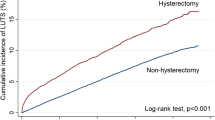Abstract
In recent years there has been increased awareness that the operation of total (simple) hysterectomy may have a deleterious effect upon the function of the urinary bladder and urethra. However, there have been few prospective studies undertaken to test this hypothesis.
This article reviews the evidence linking total hysterectomy with vesicourethral dysfunction, as well as the symptomatology and types of lower urinary tract abnormalities that may be encountered. The factors that have been implicated in the etiology of posthysterectomy voiding dysfunction are also discussed.
Similar content being viewed by others
References
Wake CR. The immediate effect of abdominal hysterectomy in intravesical pressure and detrusor activity. Br J Obstet Gynaecol 1980; 87:901–902
Parys BT, Woolfenden KA, Parsons KF. Bladder dysfunction after simple hysterectomy: urodynamic and neurological evaluation. Eur Urol 1990; 17:129–133
Hanley HG. Urge incontinence. Br J Urol 1965; 37:678–680
Hanley HG. The late urological complications of total hysterectomy. Br J Urol 1969; 41:682–684
Jacobo E. Diseases of the urethra. In: Buchsbaum HJ, Schmidt JD, eds. Gynecologic and obstetric urology. Philadelphia: Saunders, 1985: 332–333
Jequier AM. Urinary symptoms and total hysterectomy. Br J Urol 1976; 48:437–441
Kilkku, P. Supravaginal uterine amputation versus hysterectomy with reference to subjective bladder symptoms and incontinence. Acta Obstet Gynecol Scand 1985; 64:375–379
Smith P, Roberts M, Slade N. Urinary symptoms following hysterectomy. Br J Urol 1970; 42:3–9
Slade, N, Mather, HG, Linton KB, Leather HM, Powell DEB. Sequels of post-operative urinary infection in women. Br Med J 1965; I:1278–1281
Gibbon NOK, Parsons KF, Woolfenden KA. The neuropathic urethra. Paraplegia 1980; 18:221–225
Petri E. Bladder dysfunction after radical surgery. In: Ostergard DR, ed. Gynecologic urology and urodynamics. Theory and practice. Baltimore: Williams and Wilkins, 1985: 545–555
Farghaly SA, Hindmarsh JA, Worth PHL. Post hysterectomy urethral dysfunction: evaluation and management. Br J Urol 1986; 58:299–302
Brown ADG, Weir J, Jequier ADM, Whiteside CG, Turner Warwick R. A urodynamic study of the effect of hysterectomy on the bladder. In: Proceedings of the 4th annual meeting of the International Continence Society, 1974; Mainz, 3.
Langer R, Neuman M, Ron-El R, Golan A, Bukovsky I, Caspi E. The effect of total abdominal hysterectomy on bladder function in asymptomatic women. Obstet Gynecol 1989; 74:205–207
Parys BT, Haylen BT, Hutton JL, Parsons KF. The effects of simple hysterectomy on vesicourethral function. Br J Urol 1989; 64:594–599
Snooks SJ, Badenoch DF, Tiptaft RC, Swash M. Perineal nerve damage in genuine stress urinary incontinence. An electophysiological study. Br J Urol 1985; 57:422–426
Hoins, J, Hudson CN. Shaw's textbook of operative gynaecology. Churchill Livingstone, Edinburgh, 1983: 129–137
Tanagho EA. Effect of hysterectomy and periurethral surgery on urethrovesical function. In: Ostergard DR, ed. Gynecologic urology and urodynamics. Theory and practice. Baltimore: Williams and Wilkins, 1985: 537–544
Roberts M, Smith P. Non-malignant obstruction of the female urethra. Br J Urol 1968; 40:694–702
Knutsen, K. The climacteric following supra-vaginal hysterectomy. Acta Obstet Gynecol Scand 1951; 31:9–24
Whitelaw RG. Ovarian activity following hysterectomy. J Obstet Gynaecol Br Emp 1958; 65:917–932
McCrea LE. The importance of vesical innervation in extended pelvic surgery. West J Surg Obstet Gynecol 1955; 63:284–287
Rankin JT. Urological complications of rectal surgery. Br J Urol 1969; 41:655–659
Mundy AR. An anatomical explanation for bladder dysfunction following rectal and uterine surgery. Br J Urol 1982; 54:501–504
Taylor T, Smith AN, Fulton PM. Effect of hysterectomy on bowel function. Br Med J 1989; 299:300–301
Goldrath MH, Fuller TA, Segal S. Laser photovaporisation of endometrium for the treatment of menorrhagia. Am J Obstet Gynecol 1981; 140:14–19
DeCherney AH, Polan ML. Hysteroscopic management of intrauterine lesions and intractable uterine bleeding. Obstet Gynecol 1983; 61:392–397
Magos AL. Baumann R, Turnbull AC. Transcervical resection of endometrium in women with menorrhagia. Br Med J 1989; 298:1209–1212
Author information
Authors and Affiliations
Rights and permissions
About this article
Cite this article
Parys, B.T. Lower urinary tract dysfunction after total hysterectomy. Int Urogynecol J 2, 108–111 (1991). https://doi.org/10.1007/BF00376574
Issue Date:
DOI: https://doi.org/10.1007/BF00376574



